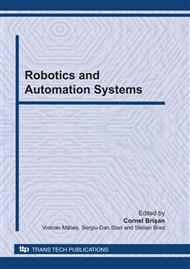p.253
p.259
p.265
p.271
p.277
p.285
p.291
p.297
p.303
Development of a Tactile Sensor Array
Abstract:
Flexible grasping robots are needed for enabling automated, profitable and competitive production of small batch sizes including complex handling processes of often fragile objects. This development will create new conditions for value-adding activities in the production of the future world. The paper describes the related research work we have developed for sensor design, exploration and control for a robot gripping system, in order to analyze normal forces applied on the tactile pixels for gripping force control and generate tactile images for gripping positioning and object recognition. Section 1 gives an introduction of principles and technologies in tactile sensing for robot grippers. Section 2 presents the sensor cell (taxel) and array design and characterization. Section 3 introduces object recognition and shape analysis ideas showing a few preliminary examples, where geometrical features of small objects are identified. Slip detection in order to define optimum grasp pressure is addressed in section 4. The paper will conclude by addressing future ideas about how to judge or forecast a good grasp quality from sensory information.
Info:
Periodical:
Pages:
277-284
Citation:
Online since:
September 2010
Authors:
Keywords:
Price:
Сopyright:
© 2010 Trans Tech Publications Ltd. All Rights Reserved
Share:
Citation:


